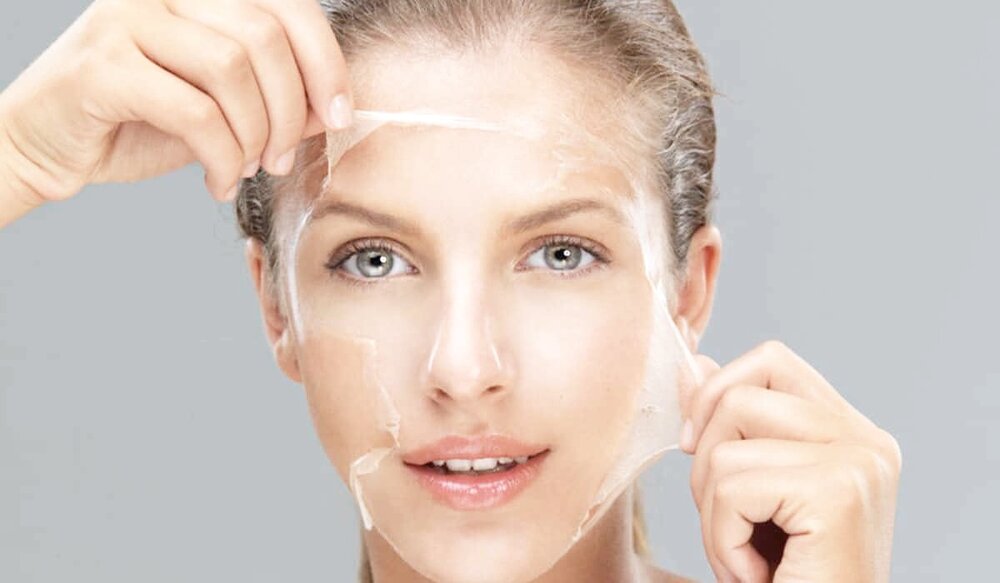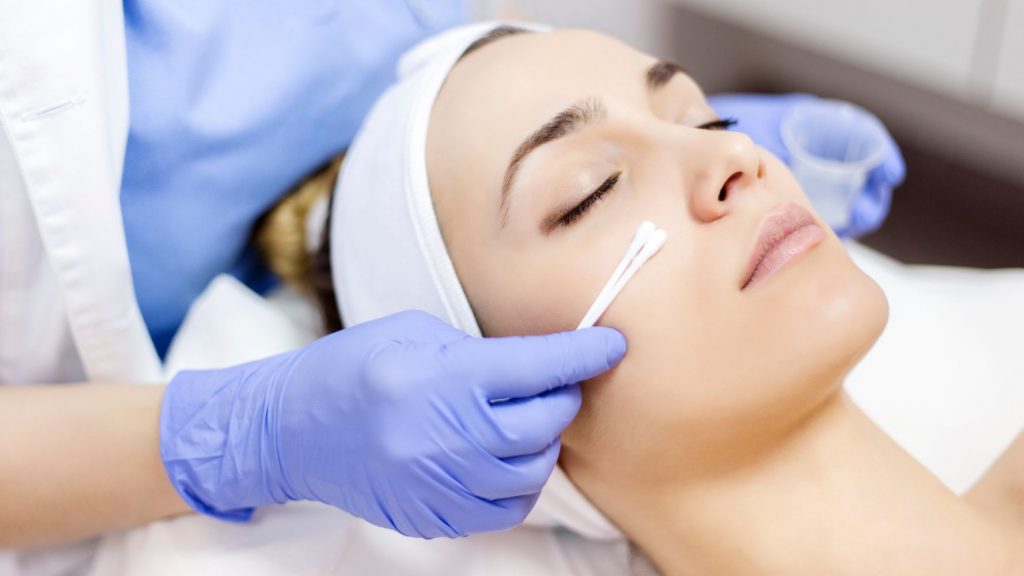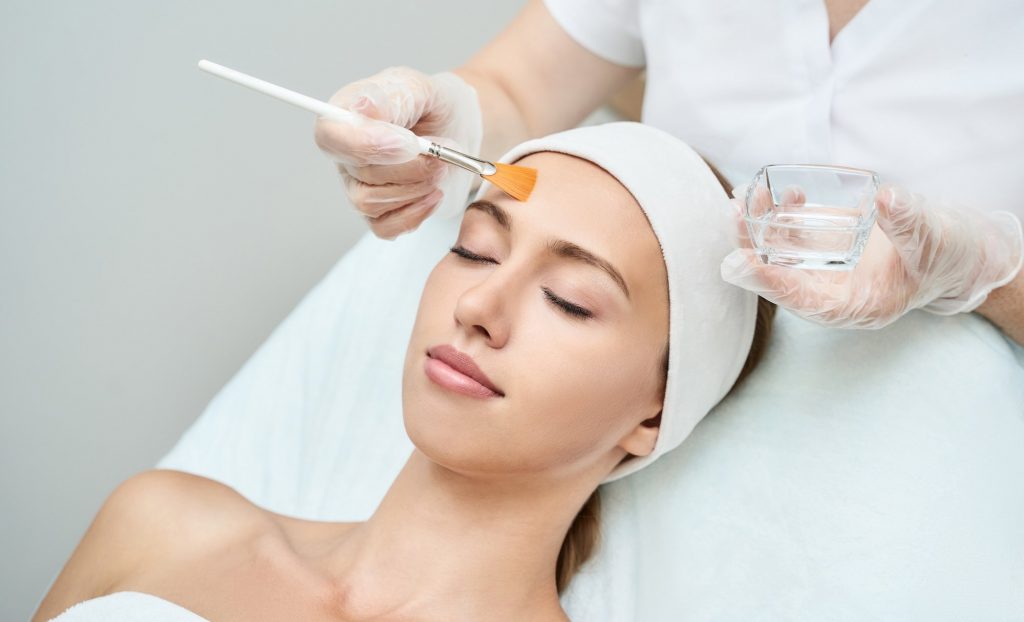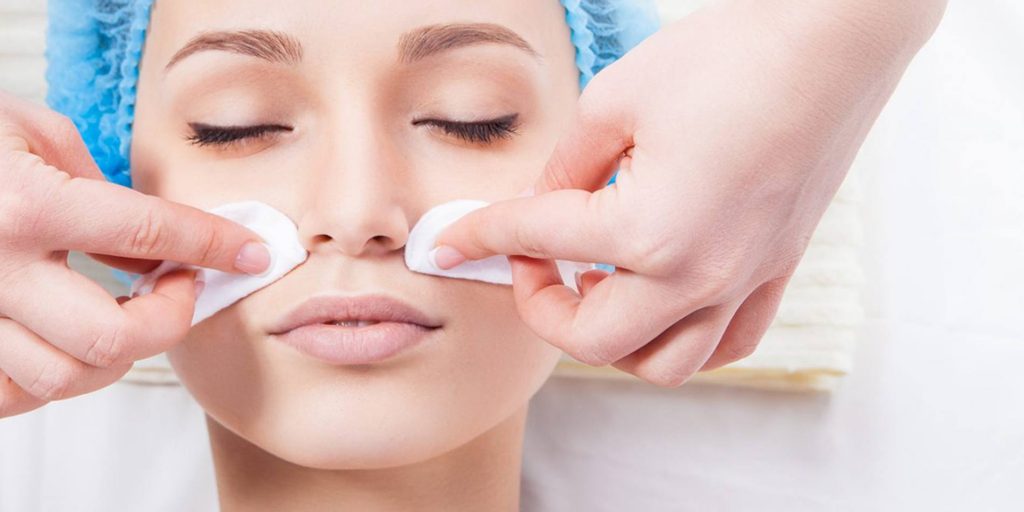Acne Treatment Dubai & Chemical Peel
Unless you are born and blessed with flawless skin, chances are extremely high that you will encounter acnes periodically throughout your life. Of course, change in your sleeping patterns, diet and lifestyle will help you prevent acne, but what about the scars left behind by them? Not that these scars are permanent, but we all know that they take forever to go away. This makes you blend with concealer on your forehead and cheeks over and over again every time you need to step out of your home.
However, if you are looking for a more refined and quick solution to getting rid of acne scars, we highly recommend you to get yourself acquainted with chemical peels.
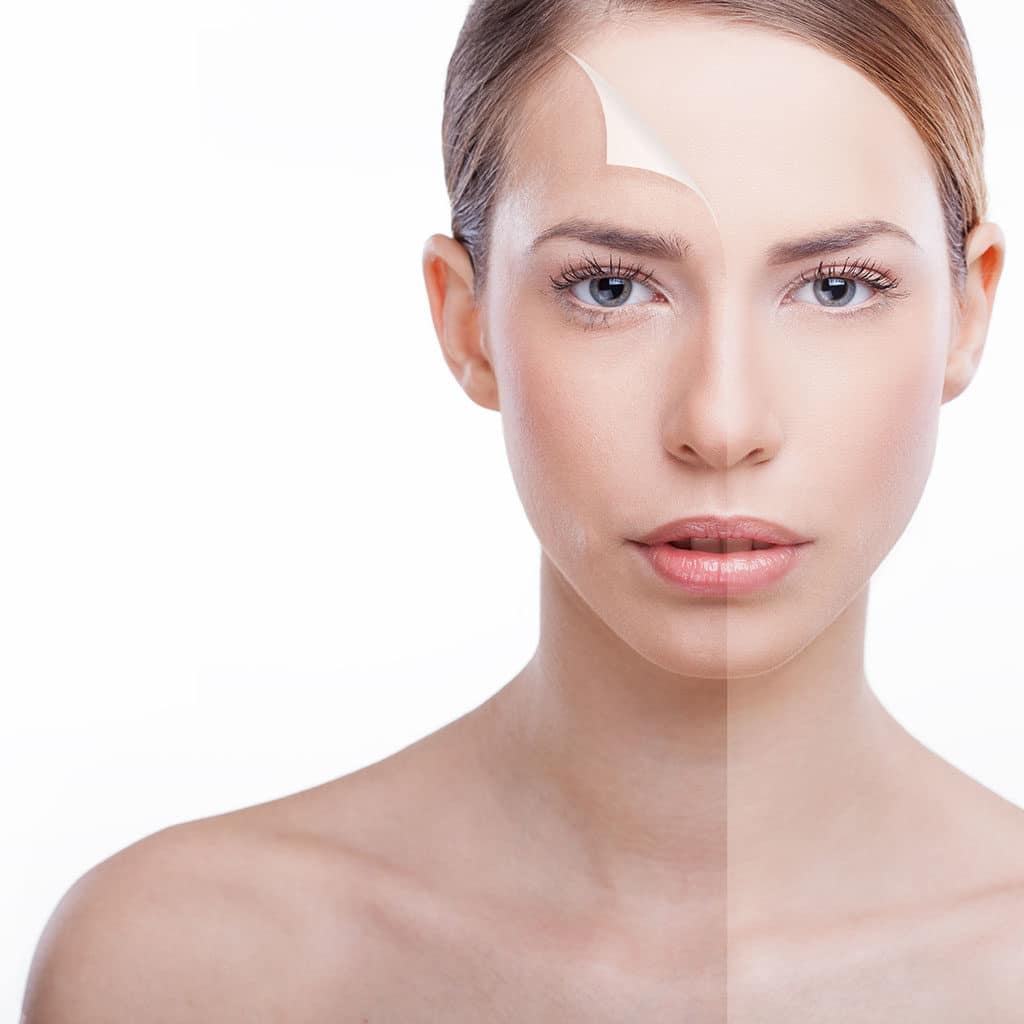
WHAT IS CHEMICAL PEEL?
Chemical peels are a strong type of chemical exfoliation wherein an acid solution is used to eliminate pore-clogging impurities and dead skin. It works on the mechanism of causing cellular level injuries to the affected area (similar to micro-needling) to surface new skin cells. They remove the top layer of unhealthy, scarred skin and allow new skin cells to develop in their place. To put it simply, the goal of chemical peels is to peel off old skin cells and replace them with new and healthier ones.
The strength of the peeling solution will be determined by the severity of the acne scars. But, it should be noted that stronger peels require a longer downtime to heal since they cause deeper injuries than their lighter counterparts.
When used with the right technique and under the supervision of a trained professional in a controlled environment, chemical peels can even rejuvenate your complexion. In recent years, chemical peels have been recognized as a great way to maintain the health of your skin.
Now, you may think that they are just like exfoliators that you do at home. Well, yes, they are kind of exfoliators; the only difference is that they are much better at their jobs than your regular everyday exfoliators.
The trauma from the subtle injuries inflicted by chemical peels not only removes the dead skin cells on a surface level, but it also stimulates the natural response of your body to produce collagen, which in turn, helps in vanishing your acne scars.
WHAT ARE THE DIFFERENT TYPES OF CHEMICAL PEELS?
Chemical peels are broadly defined by the depth of damage in the skin that they produce. They are categorized as superficial (lunchtime peel), medium, and deep. Superficial peels do not damage skin below the epidermis, the most superficial skin layer. Medium peels may reach the superficial layer of the dermis, the deeper layer of the skin. Deep peels generally reach the deeper layers of the dermis. The depth of damage depends on the nature and concentration of the chemicals in the peeling solution and the length of time they are permitted to interact with the skin. Popular chemicals in peeling solutions include retinoids (tretinoin dissolved in propylene glycol), alpha-hydroxy acids (lactic acid and glycolic acid), beta-hydroxy acids (salicylic acid), trichloroacetic acid, and phenol (carbolic acid). Jessner’s solution, a combination of resorcinol (14 g), salicylic acid (14 g), and lactic acid (85%) in ethanol (95%).
WHO IS THE IDEAL CANDIDATE FOR CHEMICAL PEEL?
This treatment is not for you if you are breastfeeding or are pregnant. This treatment is also not for you if you suffer from severe active acne. You are an ideal candidate for chemical peel treatments if you suffer from superficial acne or acne scars and have fair skin.
PROCEDURE
A chemical peel can be performed in a doctor’s office or in a surgery center as an outpatient procedure. Your skin will be thoroughly cleansed with an agent that removes excess oils, while your eyes and hair are protected. A chemical solution is then applied to your skin. Chemical solutions typically used include glycolic acid, trichloroacetic acid, salicylic acid, lactic acid or carbolic acid (phenol). The different types of chemicals cause a controlled injury, each penetrating through to a different skin depth, then peeling away to reveal a new layer of skin.
The different chemical solutions provide different results. The choice of chemical depends on your goal. You will work with your dermatologist to determine the depth of your peel.
- A light (“lunchtime”) chemical peel provides subtle improvement over time and is often done in a series. The outermost layer of skin is removed. This choice may be best if you have fine wrinkling, acne, uneven skin coloring or dry, rough sun-damaged skin to help promote a healthy glow. Recovery from this type of peel may be within hours to a few days but with little to no down time.
- A medium chemical peel gives your skin a smooth, fresh look. The outermost layer and the upper part of your middle skin layer are removed. This choice may be best if you have uneven or moderate skin discoloring, age spots, acne scarring or fine-to-moderate wrinkles. Recovery from this type of peel may take a week or more and require some down time.
- A deep chemical peel produces the most dramatic results. This chemical penetrates down to the lower middle layer of your skin. Recovery time is longer with a deep peel. This choice may be best if you have moderate lines and wrinkles, extensive sun-damaged skin, deep acne scars, blotchy skin, and/or precancerous growths called actinic keratosis. A deep chemical peel requires pretreatment for up to eight weeks. Your doctor will provide specific instructions. A deep chemical peel is a one-time only treatment if applied to your face and does have significant down time.
To prepare for your chemical peel, some general instructions include:
- Avoid tanning and direct sun exposure for two weeks before each treatment.
- Apply topical products (such as hydroquinone) as instructed before treatment to prepare your skin.
- Don’t use any products containing retinoids (such as tretinoin) one to two weeks before treatment, unless your physician tells you differently.
- If you have been prescribed oral antibiotics or an oral antiviral medicine, start taking it at least 24 hours before your chemical peel.
- Peel areas must be free of any open sores, lesions or skin infections.
Your doctor will give you specific instructions for your peel type and your unique skin condition.
Day of peel: Your skin will be thoroughly cleaned. If you are having a deep chemical peel, you will receive general anesthesia (you will be asleep).
The procedure: During a chemical peel, solution is applied to your skin. You may feel a warm to somewhat hot sensation that will last a few minutes. This is followed by a stinging sensation. To relieve the sting, a cool compress may be applied your skin. The chemical is then washed off and/or neutralized.
Chemical peels are typically done in-office; deep peels may be done in an outpatient surgical facility. Before the procedure, they will likely have you tie back your hair. Your face will be cleaned, and eye protection like goggles or gauze may be applied.
Your doctor may numb the area with a topical anesthetic, especially if you’re receiving a deep peel. For deep peels, your doctor may also use a regional anesthetic, which will numb large areas. They are particularly likely to do this if you’re having your face and neck treated. For deep peels, you’ll also be given an IV, and your heart rate will be closely monitored.
Light peel
During a light peel a cotton ball, gauze, or brush will be used to apply a chemical solution like salicylic acid to the area being treated. The skin will start to whiten, and may have a slight stinging sensation. Once complete, the chemical solution will be removed or a neutralizing solution will be added.
Medium peel
During a medium chemical peel, your doctor will use a gauze, special sponge, or a cotton-tipped applicator to apply the chemical solution to your face. This may contain glycolic acid or trichloroacetic acid. A blue color may be added to the trichloroacetic acid, commonly known as a blue peel. The skin will begin to whiten, and your doctor will apply a cool compress to the skin. You may feel stinging or burning for up to 20 minutes. No neutralizing solution is needed, though they may give you a hand-held fan to cool your skin. If you’ve had the blue peel you will have a blue coloring of your skin that may last for several days after the peel.
Deep peel
During a deep chemical peel, you will be sedated. The doctor will use a cotton-tipped applicator to apply phenol to your skin. This will turn your skin white or gray. The procedure will be done in 15-minute portions, to limit the skin exposure to the acid.
Chemical peels are not very demanding when it comes to beforehand preparations.
It is expected of you to be transparent to your dermatologist about the health of your skin. You need to let him or her know of any current or past skin treatments or surgeries that you have had. If you are under any medications, please inform that to him or her as well.
Try and avoid getting waxed or bleached before a peel as well.
Coming to skincare routines, try and stick with your regular ones right before the peel instead of trying new ones. This is because you never know how a new skincare regime will affect your skin. It is possible that it might activate cosmeceuticals that may end up irritating your skin. This would, in turn, lead to an uneven peeling and late recovery period.
Similarly, don’t start any new retinoids right before the peel. However, you may continue your regular ones as long as you let your dermatologist know about them. Some people assume that retinoid users need a stronger chemical peel since retinoids are themselves peeling agents that thin out your dead skin cell layer. But what they don’t realize is the fact that retinoids also help in thickening epidermis which means that the outer skin cell layer is thick, and not thin among retinoid users.
What to expect varies depending on the depth of your chemical peel.
If you’ve had a light chemical peel:
- Expect a sunburn-like reaction to occur after your peel, meaning you’ll see redness followed by scaling that lasts between three and seven days.
- Apply lotion or cream as directed until your skin heals. After your skin heals, apply daily sunscreen.
- You can wear makeup immediately after treatment or the next day.
- Additional peels may be repeated every two to five weeks until you achieve your desired results. Typically three to five peels are needed to achieve your goal.
If you’ve had a medium chemical peel:
- Expect some redness, swelling, stinging and flaking of your skin. Swelling may last and/or worsen for 48 hours. Blisters can develop and will break open. Skin will crust and peel off over seven to 14 days.
- Perform daily soaks as directed by your doctor. Apply ointment after each soak. Apply lotion or cream daily. Don’t expose your skin to sunlight until completely healed.
- Antiviral medication will need to be taken for 10 to 14 days.
- You can wear makeup after five to seven days.
- Additional medium-depth peels may be repeated at six to 12 months intervals, if needed, to maintain results.
If you’ve had a deep chemical peel:
- The treatment area will be bandaged. Your bandages will be removed in a few days. Expect a healing time of 14 to 21 days.
- Perform daily soaks as directed by your doctor. Apply ointment after each soak. After 14 days, apply moisturizer as directed. Don’t expose your skin to sun for three to six months.
- Antiviral medication will need to be taken for 10 to 14 days.
- Wait at least 14 days before using any makeup.
- You can only have one deep peel performed on your face.
To get the best results, regardless of the depth of your peel, follow these tips:
- Don’t use a tanning bed or other type of indoor or even outdoor tanning while your skin is healing.
- After your skin heals, always apply a daily sunscreen.
- Apply a daily moisturizer, as directed, to keep your skin moist to prevent scarring.
Your new skin is fragile and more susceptible to complications. Your doctor will provide you with post-treatment instructions to reduce the chance of developing abnormal skin color after your peel and other complications.
If your skin itches, swells or burns, call your doctor. Scratching your skin could lead to an infection.
Avoid taking sunbaths or getting under the sun too much since your new skin cells following the chemical peel will be susceptible to sunburns. When you step outside of your home during the daytime, make sure to apply a mineral SPF 30 sunscreen with zinc oxide and wear a sun protection hat.
If you feel the necessity to wash your face within the first 24-48 hours after the treatment, avoid any foam-based products. Choose a milk-based cleanser instead. A gentle cream can be applied as well.
In addition, make sure not to use any physical scrubbing modalities such as rough paste cleaners or strong exfoliators or a loofah for a couple of days. The same goes for waxing as well.
Follow our guidance carefully and consult a dermatologist even if you are going for in-home treatments. As they say, you can never be too sure of anything.
Contrary to popular belief, the benefits of chemical peels are more than just removing dead cells. Take a look into the following list to find out about them.
Chemical peels help in:
- Removing deal skin cells
- Unclogging pores
- Reducing the appearance of acnes
- Smoothening the texture of your skin
- Evening your skin tone
- Stimulating the production of collagen
- Lightening dark spots
- Boosting your skin’s very own internal hyaluronic acid
- Improving the efficacy and penetration of skincare products

